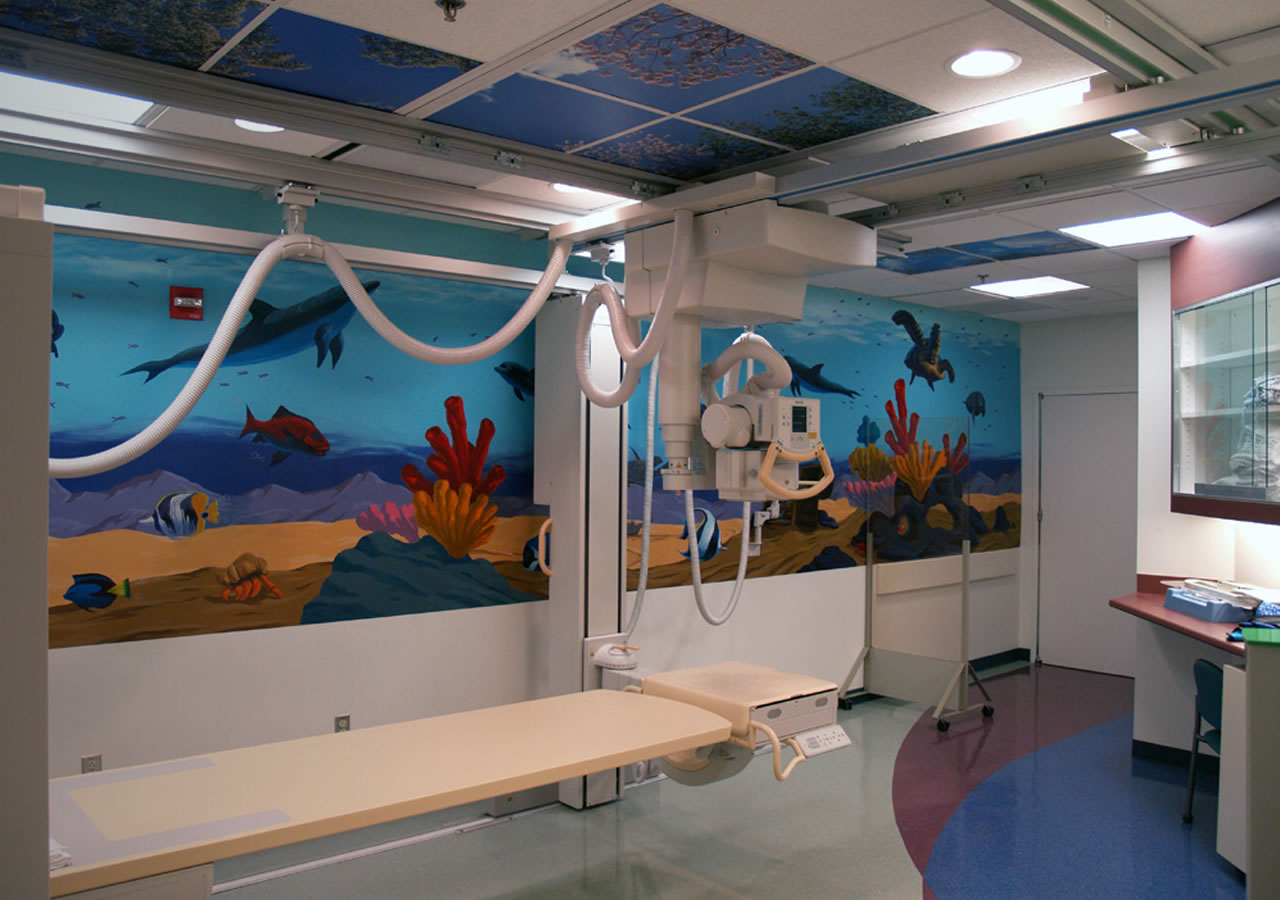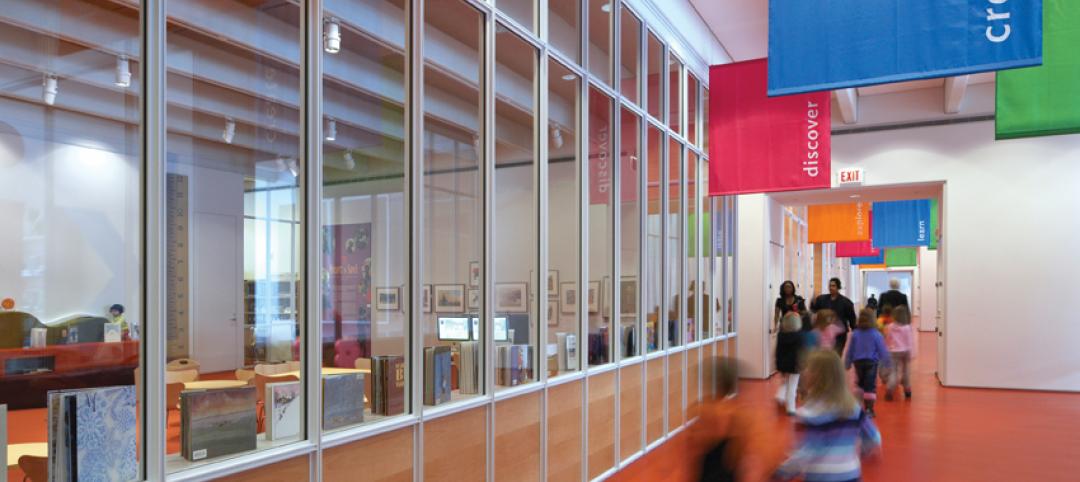As more time and money is devoted to neonatal and pediatric research, evidence-based design is playing an increasingly crucial role in the development of healthcare facilities for children. The Center for Health Design’s Knowledge Repository is an excellent storehouse of relevant research and resources on pediatric and neonatal topics.
The Facility Guidelines Institute has updated its hospital and outpatient facilities guidelines for 2014, adding the Safety Risk Assessment, as well as additional and updated design guidance that reflects the impact of lighting and acoustics on healthcare environments. The Guidelines for Design and Construction of Health Care and Outpatient Facilities are due out in early 2014 and available at www.fgiguidelines.org.
For the children and families who will be occupying these spaces, creating facilities that promote healing while offering a safe, comfortable environment is vital. The following are six important factors Provider, Design, and Construction Teams should consider when designing pediatric healthcare facilities:
1. Lighting + Acoustics—Tone it down
From neonates to teenagers, pediatric patients are different from adults in that their bodies are constantly growing and adapting to the world around them. For a child spending much of his or her days in a hospital setting, the constant exposure to indoor lighting is not healthy for still-developing eyes.
In pediatric design, it’s important to consider the user of the space. What may seem ideal from an engineering standpoint may not be practical for young patients and their families. An older eye is going to perceive light differently than a younger eye when rendering color and pattern. Allowing the patient to control lighting levels is crucial to patient-centered care.
Researchers have found that potential damage can result from children not being able to acclimate to the natural day/night cycle. Pediatric facilities now employ cycled lighting to account for the development of circadian rhythms (the biological change from day to night).
The Rady Children’s Hospital in San Diego is an example of a facility on the cutting edge of pediatric design. At night, stars appear on the ceiling—a decorative lighting element used to make the unit feel like a nighttime space.
As for acoustics, the noises associated with hospitals (especially at night) can disrupt the sleep of younger patients, hindering the healing process. Noisy hospital environments have also been known to lead to medical errors (such as incorrect medication dosages), by clinical staff.
Some hospitals utilize a “Yacker Tracker,” which was originally developed for use in educational settings. It looks like a stoplight: red, yellow, and green. When noise levels raise too high, reaching yellow or red, it is an indication to the nurse manager that voices and activity (particularly at night) need to be reduced.
2. Privacy—Options for companionship
Privacy and acoustics are closely related, as noise levels can vary based on the number of people in a room. Research in this area shows that patients, parents, and caregivers are more likely to be forthcoming to medical staff when they know others cannot overhear them.
The benefits of private rooms tend to vary based on a number of factors. Pediatric cancer patients, for example, might benefit from and desire the companionship of a roommate with a similar diagnosis and care plan. Patients recovering from an injury, on the other hand, may prefer healing alone. This should be taken into account when designing patient rooms for potential flexible and adaptable configurations, based on the care population and care model.
3. Positive Distraction—Not just pretty pictures
The concept of positive distraction extends beyond artwork to broader design themes that incorporate wayfinding and healing elements.
Simplifying the navigation around a hospital can help relieve some of the anxiety that accompanies a medical visit. Using clear wayfinding devices that incorporate “big person” and “little person” versions of the same element can be fun for children while alleviating stress for their parents.
For example, providing animal characters at a child’s height that are tactile, recognizable, and consistent from space to space on the same floor assists children in finding their way in a fun and entertaining way. Graphics, themes, and landmarks—like an indoor tree or a magical mobile or sculpture—are other ways to add a sense of wonder to what can often be a scary environment.
Creating a connection between indoor spaces and the outdoor environment can also be a successful positive distraction. Windows provide a view to the outdoors but also help remove patients from the often-clinical feeling of the hospital environment. This helps to restore homeostasis by providing the horizon as a reference and also has a positive impact on the healing process.
Common play areas for patients and families to interact can be a source of healing and distraction for children and their families. Siblings have something to do while parents are participating in the care of the patient.
4. Infection Control—Clean where it counts
Provider, Design, and Construction Teams need to think through how infection control measures shall be included during construction, as well as how to integrate them into maintenance procedures. It is recommended to clean using “touch points” as part of the protocol, such as a light switch, door handles, bed rails, chair arms, and other surfaces that come into contact with hands. From cell phone and tablet screens to bed controls and call buttons, the many devices being used in today’s healthcare units are primarily controlled by touch, which is the easiest way to transmit infection. Hand washing is still the most effective way to control the spread of infection.
The Dr. Carling Method includes the utilization of UV markers on touch points, which allowed the cleaning of touch points to be tracked with the use of a black light. Once staff was retrained to clean touch points, infection rates decreased.
5. Furnishings—Maximizing flexibility
When planning healthcare units, space is always at a premium, trying to accomplish multiple zones within patient rooms while minimizing square footage and cost. For that reason, furnishings must be compact, yet flexible enough to serve a number of purposes. They also must adapt to the needs of each particular patient.
Pediatric units must be fit to serve children of all ages. The care plan for a five-year-old will be different from that of a 15-year-old. Provider, Design, and Construction Teams must take the varying treatment scenarios into consideration when specifying furnishings for a unit. Creating a space that is adaptable to a variety of circumstances can help save costs and precious floor space.
Pediatric patients often have visitors at all hours of the day and at least one parent spending the night. To address this problem, one manufacturer offers a couch that can convert into two chairs and a table and can be easily made into a bed for overnight visitors. Talk about flexibility!
6. Surfaces—Seamless is best
In specifying floor materials, seamless surfaces are best, particularly where infection risk is highest, such as surgical areas. For sinks, solid surfaces with integral sink bowls minimize seams, contributing to infection control measures. Infection risk can also be minimized through careful selection of furnishings and materials. The less porous a surface, the easier it is to clean and maintain.
The common misconception among maintenance staff is that if something is shiny, it is clean. However, shiny does not equate with clean, as a non-waxed surface takes less water, chemicals, and down time than a highly polished waxed surface. Shiny floors create glare that can be distracting and contribute to falls, as shiny spots are often mistaken for wet areas. Design professionals should evaluate matte surfaces with a high coefficient of friction to reduce fall risk.
ABOUT THE AUTHOR
Jane Rohde, AIA, FIIDA, ACHA, AAHID, LEED AP, champions a widespread global cultural shift toward de-institutionalized senior living facilities through her consulting, sustainable approach, research, and advocacy, which provides services to nonprofit and for-profit developers, government agencies, and senior living and healthcare providers. She also provides education to providers, regulators, and peers on senior living and healthcare trends, programming, and design that supports and improves the lives of elders and patients.
Rohde’s consulting practice includes the promotion of person-centered environments, sustainability, and universal design solutions. She sits on the Environmental Standards Council, part of The Center for Health Design, and is the former AAHID Board of Regents VP. Her leadership has garnered the creation of the Facility Guidelines Institute’s Guidelines for Design and Construction of Residential Health, Care, and Support Facilities, a guideline utilized as code for the licensing of long-term care and related facility types.
This groundbreaking document includes guidance on not only traditional models but provides guidance for designers, regulators, and providers for creating person-centered environments. Rohde founded and chairs the Senior Living Sustainability Guide committee, a committed group of volunteers that created a sustainability guide for senior living projects that has been accessed for utilization in more than 10 countries, including China Senior Care, the first residential aged-care facility in China that focuses on skilled nursing and adult day care. Rohde speaks internationally on senior living, aging, healthcare, evidence-based design, and sustainability.
Related Stories
| Feb 11, 2011
Iowa surgery center addresses both inpatient and outpatient care
The 12,000-person community of Carroll, Iowa, has a new $28 million surgery center to provide both inpatient and outpatient care. Minneapolis-based healthcare design firm Horty Elving headed up the four-story, 120,000-sf project for St. Anthony’s Regional Hospital. The center’s layout is based on a circular process flow, and includes four 800-sf operating rooms with poured rubber floors to reduce leg fatigue for surgeons and support staff, two substerile rooms between each pair of operating rooms, and two endoscopy rooms adjacent to the outpatient prep and recovery rooms. Recovery rooms are clustered in groups of four. The large family lounge (left) has expansive windows with views of the countryside, and television monitors that display coded information on patient status so loved ones can follow a patient’s progress.
| Feb 11, 2011
Grocery store anchors shopping center in Miami arts/entertainment district
18Biscayne is a 57,200-sf urban retail center being developed in downtown Miami by commercial real estate firm Stiles. Construction on the three-story center is being fast-tracked for completion in early 2012. The project is anchored by a 49,200-sf Publix market with bakery, pharmacy, and café with outdoor seating. An additional 8,000 sf of retail space will front Biscayne Boulevard. The complex is in close proximity to the Adrienne Arsht Center for the Performing Arts, the downtown Miami entertainment district, and the Omni neighborhood, one of the city’s fast-growing residential areas.
| Feb 11, 2011
Chicago architecture firm planning one of China’s tallest towers
Chicago-based Goettsch Partners was commissioned by developer Guangzhou R&F Properties Co. Ltd. to design a new 294,570-sm mixed-use tower in Tianjin, China. The Tianjin R&F Guangdong Tower will be located within the city’s newly planned business district, and at 439 meters it will be one of China’s tallest buildings. The massive complex will feature 134,900 sm of Class A office space, a 400-key, five-star hotel, 55 condominiums, and 8,550 sm of retail space. The architects are designing the tower with multi-story atriums and a high-performance curtain wall to bring daylight deep into the building, thereby creating deeper lease spans. The project is currently finishing design.
| Feb 11, 2011
Two projects seek to reinvigorate Los Angeles County medical center
HMC Architects designed two new buildings for the Los Angeles County Martin Luther King, Jr., Medical Center as part of a $360 million plan to reinvigorate the campus. The buildings include a 120-bed hospital, which involves renovation of an existing tower and several support buildings, and the construction of a new multi-service ambulatory care center. The new facilities will have large expanses of glass at all waiting and public areas for unobstructed views of downtown Los Angeles. A curved glass entrance canopy will unite the two buildings. When both projects are completed—the hospital in 2012 and the ambulatory care center in 2013—the campus will have added more than 460,000 sf of space. The hospital will seek LEED certification, while the ambulatory care center is targeting LEED Silver.
| Feb 11, 2011
Sustainable community center to serve Angelinos in need
Harbor Interfaith Services, a nonprofit serving the homeless and working poor in the Harbor Area and South Bay communities of Los Angeles, engaged Withee Malcolm Architects to design a new 15,000-sf family resource center. The architects, who are working pro bono for the initial phase, created a family-centered design that consolidates all programs into a single building. The new three-story space will house a resource center, food pantry, nursery and pre-school, and administrative offices, plus indoor and outdoor play spaces and underground parking. The building’s scale and setbacks will help it blend with its residential neighbors, while its low-flow fixtures, low-VOC and recycled materials, and energy-efficient mechanical equipment and appliances will help it earn LEED certification.
| Feb 11, 2011
Texas megachurch inspired by yesteryear’s materials, today’s design vocabulary
The third phase of The First Baptist Church of Pasadena, Texas, involves construction of a new 115,000-sf worship center addition. Currently in design by Zeigler Cooper, the project will include a 2,500-seat worship center (with circular layout and space for a 50-person orchestra and 200-person choir), a 500-seat chapel (for weddings, funerals, and special events), and a prayer room. The addition will connect to the existing church and create a Christian Commons for education, administration, music, and fellowship. The church asked for a modern design that uses traditional materials, such as stone, brick, and stained glass. Construction is scheduled to begin this summer.
| Feb 11, 2011
Apartment complex caters to University of Minnesota students
Twin Cities firm Elness Swenson Graham Architects designed the new Stadium Village Flats, in the University of Minnesota’s East Bank Campus, with students in mind. The $30 million, six-story residential/retail complex will include 120 furnished apartments with fitness rooms and lounges on each floor. More than 5,000 sf of first-floor retail space and two levels of below-ground parking will complete the complex. Opus AE Group Inc., based in Minneapolis, will provide structural engineering services.
| Feb 11, 2011
Four-story library at Salem State will hold half a million—get this—books!
Salem State University in Massachusetts broke ground on a new library and learning center in December. The new four-story library will include instructional labs, group study rooms, and a testing center. The modern, 124,000-sf design by Boston-based Shepley Bulfinch includes space for 500,000 books and study space for up to a thousand students. Sustainable features include geothermal heating and cooling, rainwater harvesting, and low-flow plumbing fixtures.
| Feb 11, 2011
Green design, white snow at Egyptian desert retail complex
The Mall of Egypt will be a 135,000-sm retail and entertainment complex in Cairo’s modern 6th of October district. The two-story center is divided into three themed zones—The City, which is arranged as a series of streets lined with retail and public spaces; The Desert Valley, which contains upscale department stores, international retailers, and a central courtyard for music and other cultural events; and The Crystal, which will include leisure and entertainment venues, including a cinema and indoor snow park. RTKL is designing the massive complex to LEED Silver standards.
| Feb 10, 2011
7 Things to Know About Impact Glazing and Fire-rated Glass
Back-to-basics answers to seven common questions about impact glazing and fire-rated glass.

















